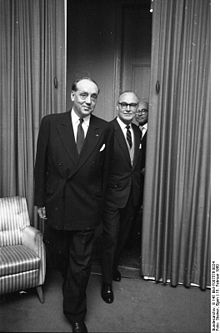|
Arne Skaug
Arne Skaug (6 November 1906 – 4 March 1974) was a Norwegian economist, civil servant, diplomat and politician for the Labour Party. He is known as director of Statistics Norway from 1946 to 1948, Norwegian Minister of Trade and Shipping from 1955 to 1962 and later ambassador. Early life and careerHe was born in Horten as a son of Johan Anton Skaug (1881–1956) and Jenny Lovise Olsen (1882–1917). He graduated with the cand.oecon. degree in 1930, and was hired as a secretary in Statistics Norway in the same year. He continued to work there, except for study leaves from 1935 to 1936 in London. In 1935 and 1936 he released two books: Tidens sosialøkonomi and Dør vi ut? Befolkningsspørsmålet og arbeiderbevegelsen, both written together with Aase Lionæs. In 1939 he was hired in the Ministry of Provisioning, and was a research fellow in economics. He then spent the war years in the United States; first with studies from 1939 to 1941 and as assisting professor at the University of Wisconsin, Madison from 1941. From 1942 to 1946 he worked for Norwegian government in New York City and Washington DC.[1] Post-war careerIn 1946 he returned to Norway to become the director of Statistics Norway. In May 1948 he left to become State Secretary in the Ministry of Foreign Affairs,[1] becoming the first in the Ministry of Foreign Affairs to hold the State Secretary position, which had been introduced in 1947.[2] He left this position in February 1949 to become the Norwegian ambassador to the Organisation for Economic Co-operation and Development in Paris. From January 1955 to January 1962 he served as the Minister of Trade and Shipping in Gerhardsen's Third Cabinet.[1] He was also the acting Minister of Foreign Affairs from August to October 1957 and December 1960 to February 1961, when Halvard Lange had absences of leave.[3] He was then the ambassador to the United Kingdom and Ireland from 1962 to 1968, and to Denmark from 1968 to 1974. He died in March 1974.[1] Skaug was heavily decorated. He was a Commander of the Greek Order of the Phoenix, and held the Grand Cross of the British Royal Victorian Order, the Swedish Order of the Polar Star, the Portuguese Order of Christ, the Siamese Order of the White Elephant, the Persian Order of the Lion and the Sun, the Danish Order of the Dannebrog, the Belgian Order of the Crown, the Icelandic Order of the Falcon[4] , the Finnish Order of the Lion and the Royal Norwegian Order of St. Olav.[1] References
|
||||||||||||||||||||||||||||||||||||
